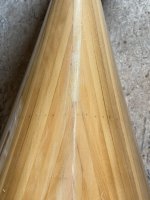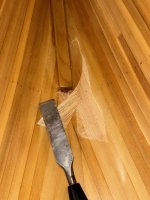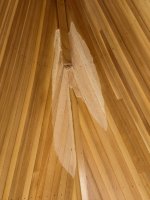Stripperguy’s saying that “every scar tells a story” is true for us and we now have a story that requires repair. We enjoyed a leisurely, lovely Moose River Bow Trip out of Jackman, ME 5/21-26/24. We almost cleared the ledge drop at Mosquito Rips unscathed, but the stern stem hit HARD as we exited. Hull inspection that night at camp showed nothing noteworthy on the exterior. The exterior layup is 6 oz E glass, and 5 inch waterline football plus 4 inch and 2 inch wide bias cut stem strips of 6 oz S glass. Back home, washing the canoe to put away, I noticed the interior glass around the stern stem was bubbled up. Remarkably, there was no water intrusion or wetting of the wood core. I suspected that I’d done a poor job of squeegeeing at wet out and that caused the failure. But all removed fiberglass (6 oz S glass) was covered with wood fiber, sometimes deeply.
I’m surprised that the damage is only to the interior, particularly considering that the location is probably the strongest, stiffest part of the hull. I guess I don’t need to understand it, just fix it.
I’m surprised that the damage is only to the interior, particularly considering that the location is probably the strongest, stiffest part of the hull. I guess I don’t need to understand it, just fix it.



